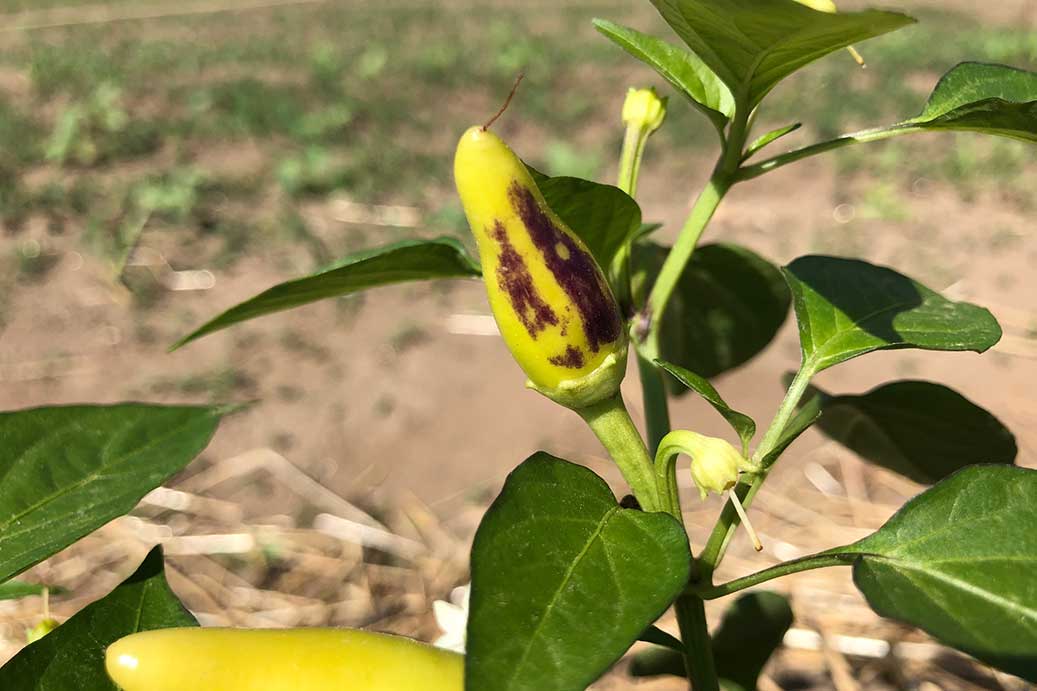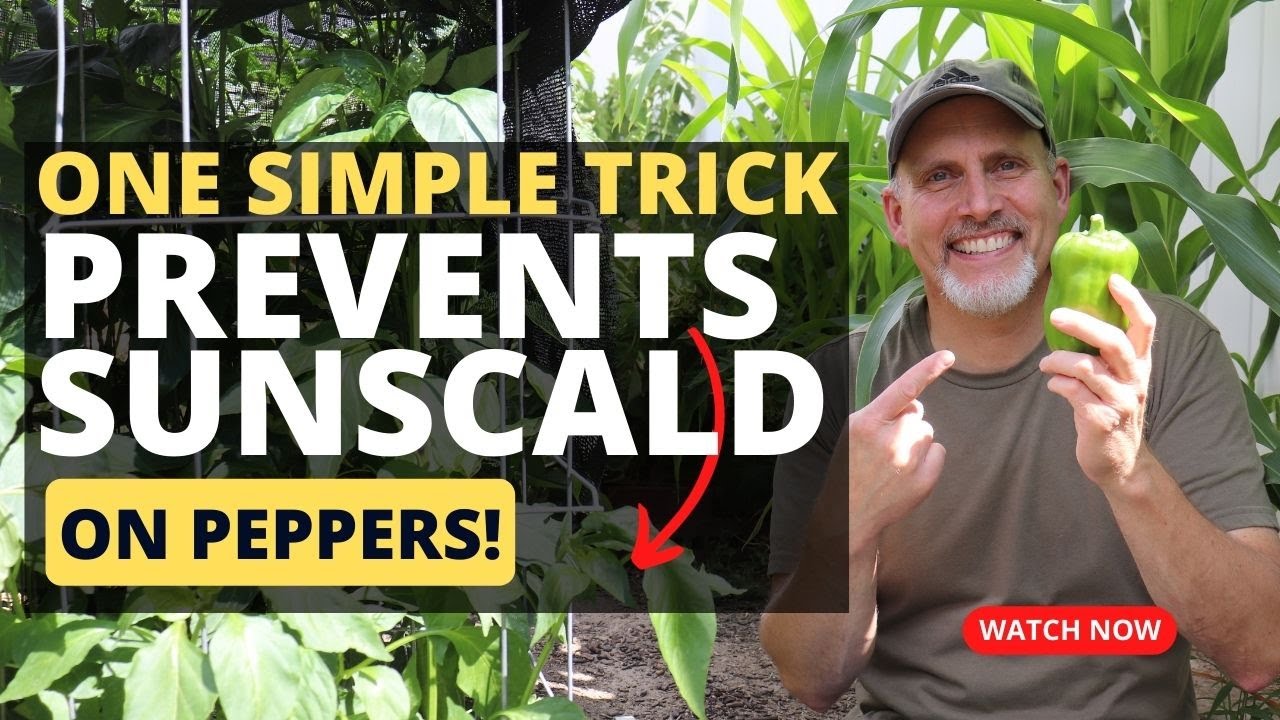To prevent sunscald on peppers, provide shade or use shade cloth. Sunscald can cause discoloration and damage to the peppers’ skin due to excessive sun exposure.
Protecting the plants from direct sunlight helps prevent this issue. Sunscald is a common problem for peppers, especially during hot summer months. We will explore the causes of sunscald, its effects on pepper plants, and most importantly, effective strategies for prevention.
By implementing these measures, you can ensure your peppers stay healthy and blemish-free throughout the growing season.

Credit: peppergeek.com
What Is Sunscald On Peppers?
Sunscald on peppers is a condition caused by excessive exposure to sunlight. It occurs when the peppers are not adequately protected by their foliage, resulting in damage to the outer layer of the fruit. Sunscald manifests as discolored patches, usually white or pale yellow, on the affected peppers.
This discoloration is a result of the sun’s intense rays scorching the exposed areas. Factors that contribute to sunscald include hot weather, sparse foliage, and insufficient shade. Lack of proper air circulation around the plants can also exacerbate the problem.
To prevent sunscald on peppers, it is crucial to provide adequate shade and protection, especially during the hottest parts of the day. Consider using shade cloths or planting the peppers in areas with partial shade. Regular pruning of the foliage can also help maintain proper airflow and minimize the risk of sunscald.
Signs And Symptoms Of Sunscald On Peppers
Sunscald on peppers can be prevented through careful observation of its signs and symptoms. Visual indicators are important in identifying sunscald, differentiating it from other diseases. Sunscald manifests as white or yellow patches on the peppers’ skin, which eventually turn brown and become shriveled.
This condition occurs when peppers are exposed to excessive sunlight, causing damage to the outer layer of the fruit. Sunscald is not a contagious disease but can still impact the overall quality and yield of the peppers. By being proactive in providing shade or using reflective materials, gardeners can significantly reduce the risk of sunscald.
Regularly monitoring the plants and taking immediate action when signs of sunscald are noticed is crucial for preventing further damage. Protecting the peppers from excessive sunlight can help ensure a healthy crop without the unsightly effects of sunscald.
How to Prevent Sunscald on Peppers: 8 Easy Steps
Weather Conditions
High temperatures have a significant impact on sunscald, causing detrimental effects on peppers. Prolonged sun exposure can pose a threat to the health of pepper plants, resulting in sunscald. The scorching heat leads to the formation of lesions on the peppers, making them vulnerable to diseases and infections.
To prevent sunscald, it is crucial to monitor weather conditions and take appropriate measures. Providing adequate shade and protecting the peppers from direct sunlight can make a significant difference. Other preventive methods include applying a reflective mulch or using shade cloth.
By implementing these tactics, you can safeguard your pepper plants and ensure they thrive even in the harshest weather conditions. Remember to prioritize sun protection to prevent sunscald and maintain the healthy growth of your peppers.
Plant Protection Techniques
Peppers are susceptible to sunscald, a condition where intense sunlight causes damage to the fruit. To protect your peppers, it is crucial to implement plant protection techniques. One effective method is to provide shade for the plants. This is important because shade helps to reduce the direct exposure of the peppers to harsh sunlight.
Using protective covers is another effective way to prevent sunscald. These covers act as a barrier, shielding the plants from intense sunlight and preventing sunburn. Additionally, you can utilize natural shading methods by planting taller crops nearby to cast shadows on the peppers.
By implementing these prevention techniques, you can safeguard your peppers from sunscald and ensure a healthy harvest. Remember to regularly monitor the plants and adjust the shading as needed to provide optimal protection. Protecting your peppers from sunscald is essential for their growth and overall productivity.
Soil And Nutrient Management
Soil plays a crucial role in preventing sunscald on peppers. Proper soil management is essential to reduce the risk of sunscald. Nutrient deficiencies can increase the susceptibility of peppers to sunscald. Ensuring that the soil is rich in nutrients, especially calcium and potassium, is important.
These nutrients help strengthen the cell walls of the peppers, making them more resistant to sun damage. Additionally, maintaining the pH level of the soil within the optimal range can also help prevent sunscald. Monitoring the soil moisture levels is equally important to avoid water stress, which can make peppers more vulnerable to sunscald.
By implementing effective soil and nutrient management practices, growers can minimize the occurrence of sunscald, ensuring healthier and more productive pepper plants. So, it is crucial to pay attention to soil health when aiming to prevent sunscald on peppers.
Proper Plant Placement
When planting peppers, proper placement is key to preventing sunscald. Choosing suitable locations is important to ensure the plants receive adequate shade. Strategically creating shade in the garden can be achieved through various strategies. One option is to utilize natural shade provided by nearby trees or structures.
Additionally, using shade cloths or umbrellas can help protect the peppers from intense sunlight. Another effective method is to plant taller crops, such as corn or sunflowers, nearby to create shadow and shield the peppers. By considering the positioning of the peppers and implementing these shade strategies, sunscald can be minimized, leading to healthier and more productive pepper plants.
With careful planning and attention to plant placement, gardeners can enjoy a bountiful harvest of sunscald-free peppers.
Adequate Watering Techniques
To prevent sunscald on peppers, it is crucial to understand their water needs. Providing adequate water to pepper plants is essential in maintaining their health and preventing sun damage. Peppers require a consistent supply of water to keep their leaves and fruits hydrated.
Implementing proper irrigation methods is key to prevent sunscald. Consider using a drip irrigation system or soaker hoses to deliver water directly to the roots. This helps to keep the foliage dry, reducing the risk of sunscald. It is also important to water peppers deeply, allowing the soil to fully absorb the moisture and promoting root development.
Regularly monitor the moisture levels in the soil and adjust watering accordingly. By following these watering techniques, you can protect your peppers from sunscald and ensure healthy plant growth.
Effective Use Of Mulch
Mulching is an effective way to prevent sunscald on peppers. Sunscald occurs when the intense heat and sunlight damage the sensitive skin of the pepper fruits. By using mulch, you can provide a protective layer to shield the peppers from direct exposure to the sun’s rays.
The benefits of using mulch for this purpose are manifold. Firstly, it helps to maintain a consistent moisture level in the soil, preventing the plants from drying out. Secondly, it acts as an insulating layer, regulating the temperature and preventing extreme fluctuations that can lead to sunscald.
Thirdly, mulch helps to suppress the growth of weeds, ensuring that the peppers receive all the nutrients and moisture they need. When choosing a mulch for peppers, opt for types that are organic and lightweight, such as straw, shredded leaves, or wood chips.
Optimal Harvesting Practices
To prevent sunscald on peppers, optimal harvesting practices should be followed. Timing the harvest is crucial in avoiding sunscald. Peppers should be harvested when they have reached their desired size and color. Handling techniques play a significant role in maintaining the quality of harvested peppers.
It is important to handle them gently to prevent any bruising or damage. Peppers should be picked using scissors or shears to prevent the stems from breaking off. After harvesting, peppers should be stored in a cool and dry place to prolong their shelf life.
Following these guidelines will help prevent sunscald and ensure the best quality peppers for consumption.
Proper Storage Conditions
Proper storage conditions play a crucial role in preventing sunscald on peppers and extending their shelf life. To maintain the quality of peppers, it is recommended to store them in a cool, dry, and well-ventilated place. The ideal temperature range for storage lies between 45-50°F (7-10°C).
Ensure that the environment is free from direct sunlight as exposure to heat can increase the risk of sunscald. It is advisable to store peppers away from ethylene-producing fruits like bananas, apples, and tomatoes, as ethylene can accelerate deterioration. Additionally, peppers should be stored in a breathable container or paper bag, allowing air circulation.
Avoid washing the peppers before storage, as moisture can promote spoilage. With these recommended storage conditions, you can significantly reduce the chances of sunscald and keep your peppers fresh for longer periods.
Frequently Asked Questions For How To Prevent Sunscald On Peppers
How Do You Protect Peppers From Sunscald?
To protect peppers from sunscald, provide shade or use protective coverings like shade cloth or umbrellas.
Will Pepper Plants Recover From Sun Scald?
Yes, pepper plants can recover from sun scald with proper care and providing shade.
Can You Eat Bell Peppers With Sunscald?
Yes, you can eat bell peppers with sunscald, as it doesn’t affect their consumption or taste.
How Do You Fix Sunscald Plants?
To fix sunscald on plants, provide shade, water regularly, and prune damaged parts.
Conclusion
Protecting your pepper plants from sunscald is crucial for a successful harvest. By understanding the causes and prevention methods, you can ensure healthy and fruitful pepper plants. One important step is to provide adequate shade to the plants, either by using shade cloth or planting taller plants nearby.
Proper watering is also essential to avoid stress on the plants and maintain consistent moisture levels. Mulching around the plants can help regulate soil temperature and retain moisture. Regularly inspect your plants for any signs of sunscald and take immediate action if necessary.
Finally, choose varieties that are more resistant to sunscald, as they will have a higher chance of withstanding intense sunlight. By implementing these preventive measures, you can safeguard your pepper plants and enjoy a bountiful harvest of vibrant and tasty peppers.

